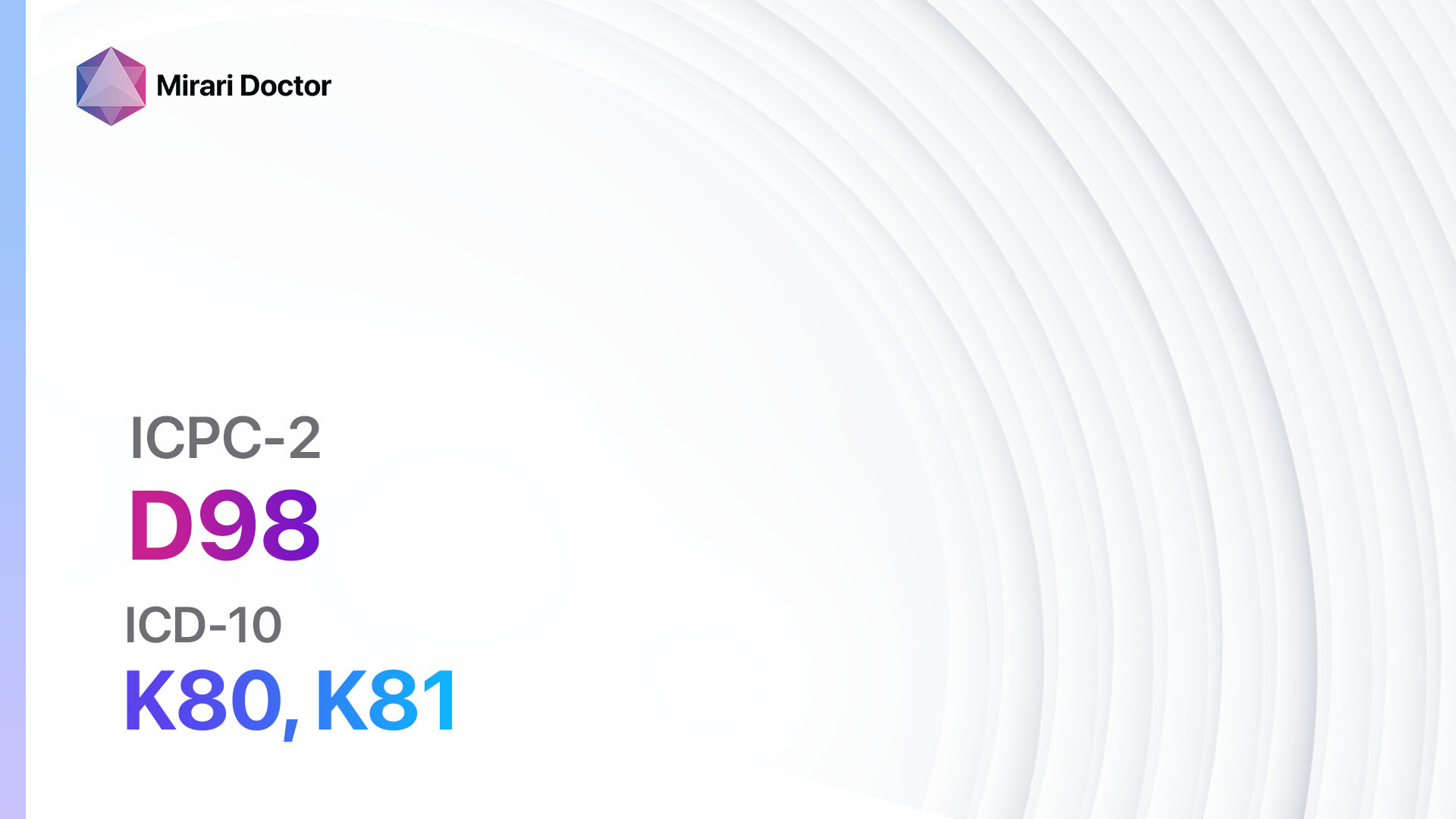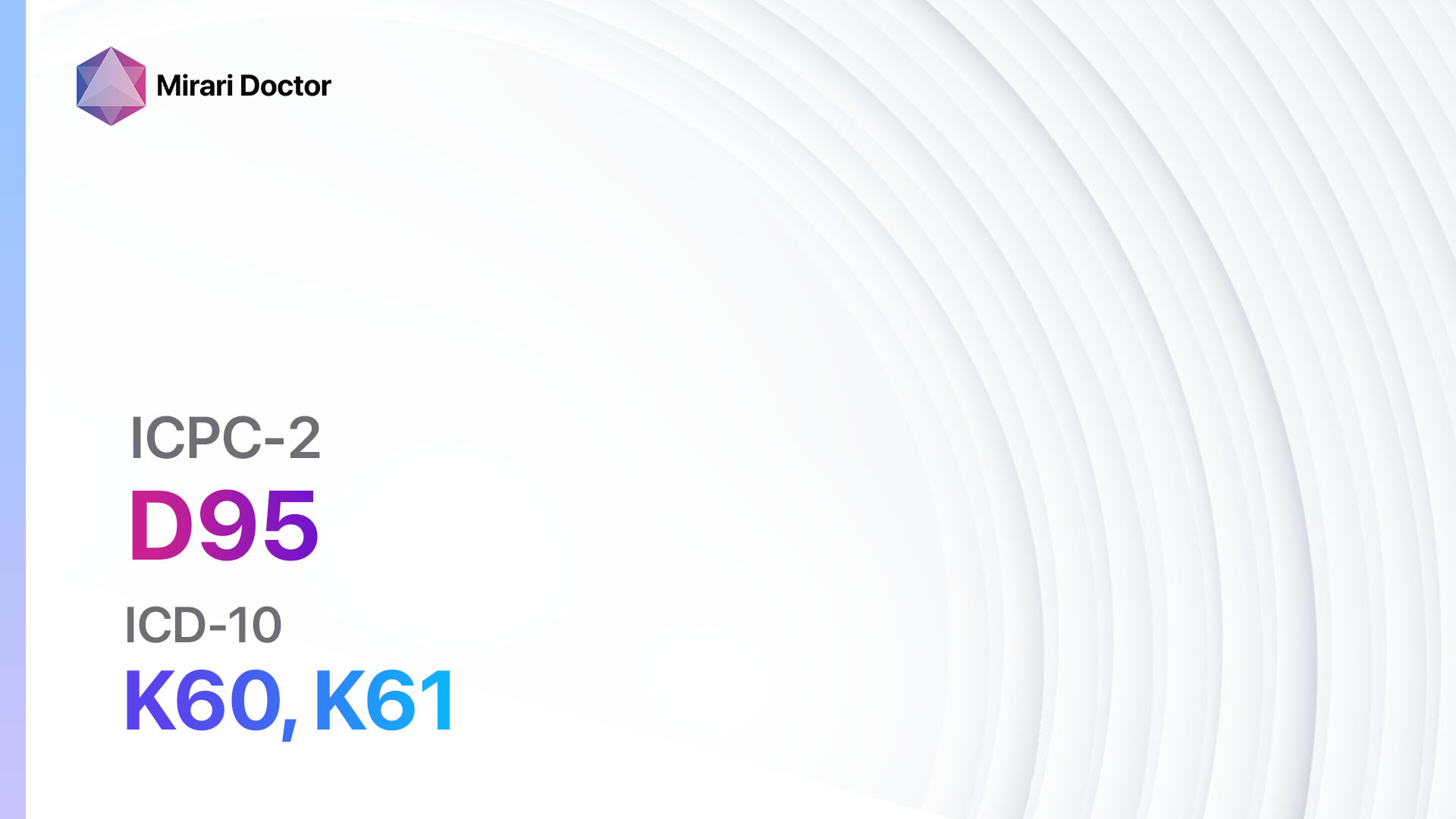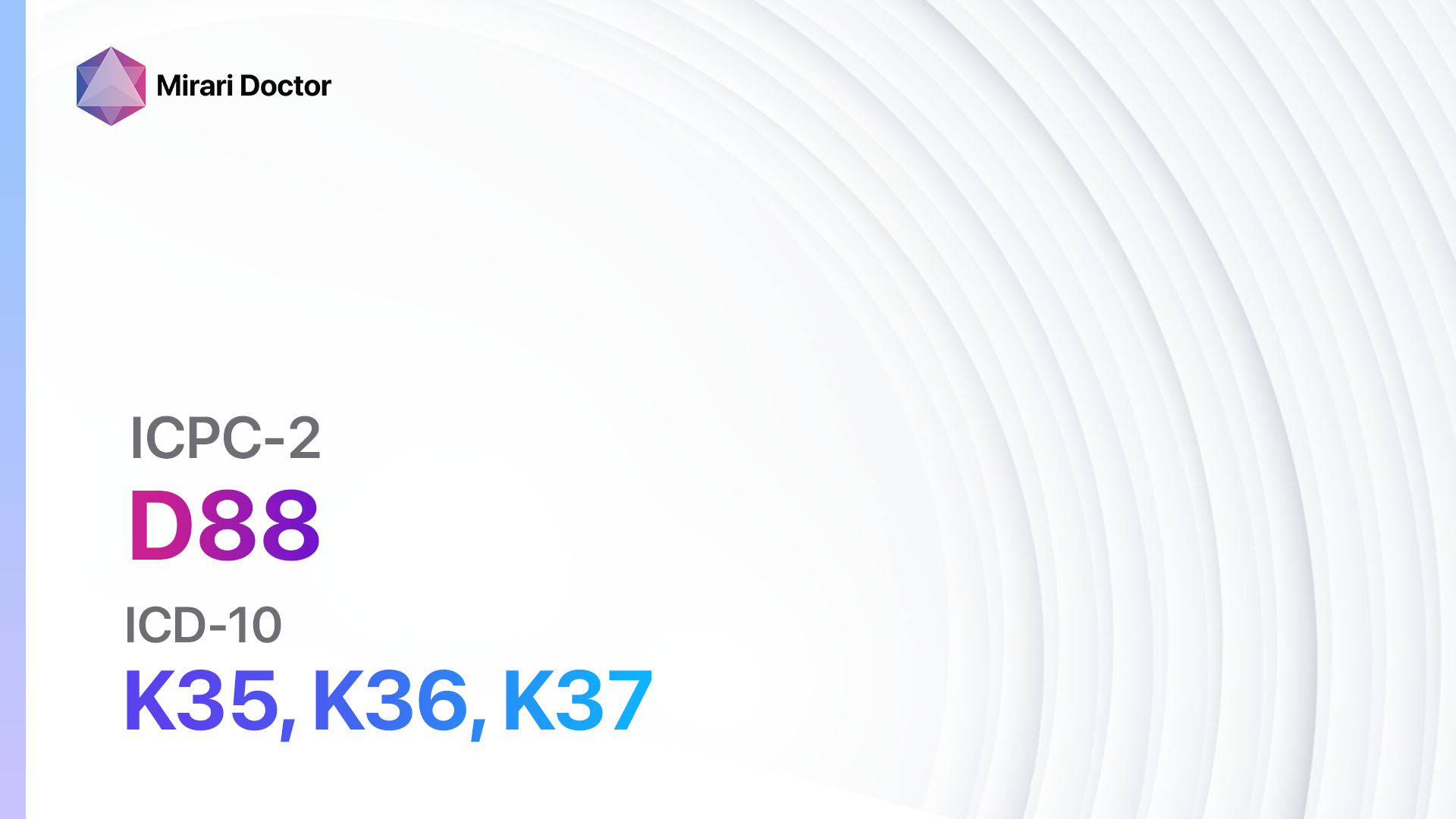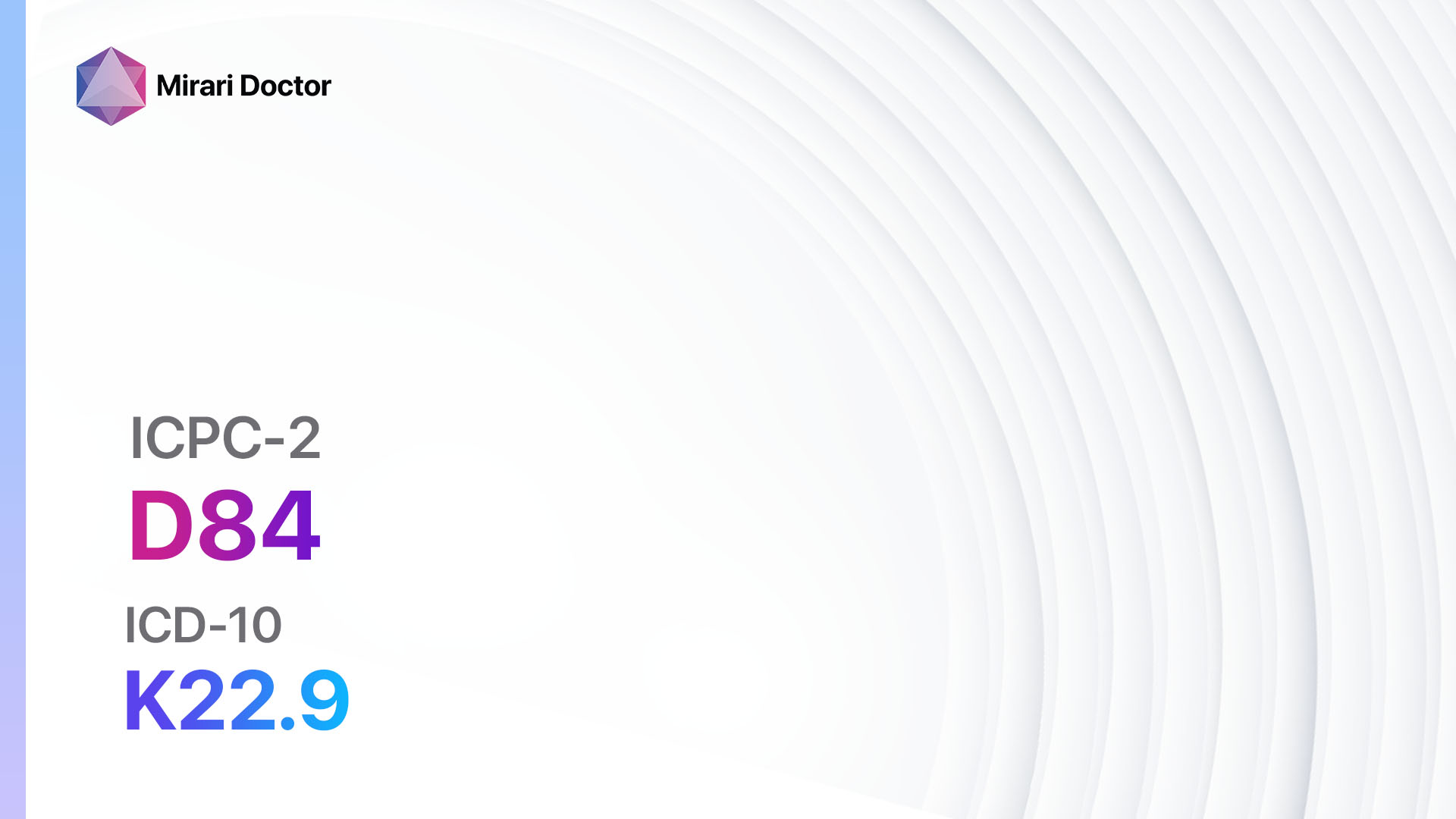
Introduction
Congenital anomalies of the digestive system refer to structural abnormalities present at birth that affect the organs and structures involved in digestion. These anomalies can range from minor malformations to life-threatening conditions[1]. The aim of this guide is to provide an overview of the symptoms, causes, diagnostic steps, possible interventions, and patient education for congenital anomalies of the digestive system.
Codes
- ICPC-2 Code: D81 Congenital anomaly digestive system[2]
- ICD-10 Code: Q45.9 Congenital malformation of digestive system, unspecified[3]
Symptoms
- Abdominal pain: Persistent or recurrent pain in the abdominal region.
- Vomiting: Frequent or forceful expulsion of stomach contents through the mouth.
- Feeding difficulties: Difficulty in swallowing or maintaining adequate nutrition.
- Failure to thrive: Inadequate weight gain or growth in infants.
- Gastrointestinal bleeding: Presence of blood in the stool or vomit.
- Jaundice: Yellowing of the skin and eyes.
- Distended abdomen: Abdominal swelling or bloating.
- Constipation: Difficulty in passing stools[4].
Causes
- Genetic factors: Mutations or abnormalities in genes responsible for the development of the digestive system.
- Environmental factors: Exposure to certain medications, toxins, or infections during pregnancy.
- Maternal factors: Poor nutrition, smoking, alcohol consumption, or drug use during pregnancy.
- Chromosomal abnormalities: Conditions such as Down syndrome or Turner syndrome[5].
Diagnostic Steps
Medical History
- Gather information about the patient’s prenatal history, including maternal health, exposure to teratogens, and any known genetic conditions in the family.
- Document the patient’s symptoms, including the duration, severity, and any associated factors.
- Assess the patient’s feeding history, including difficulties, vomiting, or poor weight gain.
- Inquire about any previous surgeries or interventions related to the digestive system[6].
Physical Examination
- Perform a thorough examination of the abdomen, looking for any abnormalities, distention, or tenderness.
- Assess the patient’s growth parameters, including weight, height, and head circumference.
- Examine the patient’s skin and eyes for signs of jaundice.
- Evaluate the patient’s feeding ability and assess for any oral abnormalities[7].
Laboratory Tests
- Complete blood count (CBC): To assess for anemia or infection.
- Liver function tests: To evaluate liver function and assess for any abnormalities.
- Electrolyte panel: To check for imbalances that may be associated with digestive system anomalies.
- Genetic testing: To identify any specific genetic abnormalities or syndromes.
- Stool analysis: To assess for the presence of blood or other abnormalities[8].
Diagnostic Imaging
- X-ray: To visualize the structure and position of the digestive organs.
- Ultrasound: To assess the structure and function of the liver, gallbladder, and other abdominal organs.
- CT scan: To obtain detailed images of the digestive system and identify any abnormalities.
- MRI: To evaluate the soft tissues and blood vessels of the digestive system[9].
Other Tests
- Endoscopy: To visualize the inside of the digestive tract using a flexible tube with a camera.
- Biopsy: To obtain a sample of tissue for further analysis and diagnosis.
- Contrast studies: To evaluate the function and structure of the digestive system using contrast agents[10].
Follow-up and Patient Education
- Schedule regular follow-up appointments to monitor the patient’s growth and development.
- Provide education to the patient and their family about the specific congenital anomaly, its management, and potential complications.
- Refer the patient to appropriate specialists or support groups for further guidance and support.
Possible Interventions
Traditional Interventions
Medications:
Top 5 drugs for Congenital Anomaly of the Digestive System:
- Proton pump inhibitors (e.g., Omeprazole, Pantoprazole):
- Cost: Generic versions can be $10-$50/month.
- Contraindications: Hypersensitivity to the medication.
- Side effects: Headache, diarrhea, abdominal pain.
- Severe side effects: Clostridium difficile infection, kidney problems.
- Drug interactions: Warfarin, clopidogrel, methotrexate.
- Warning: Long-term use may increase the risk of fractures.
- Antacids (e.g., Calcium carbonate, Aluminum hydroxide):
- Cost: Over-the-counter options are available for <$10/month.
- Contraindications: Severe kidney disease, high calcium levels.
- Side effects: Constipation, diarrhea, stomach cramps.
- Severe side effects: Kidney stones, electrolyte imbalances.
- Drug interactions: Tetracycline antibiotics, iron supplements.
- Warning: Use with caution in patients with heart failure or hypertension.
- Prokinetic agents (e.g., Metoclopramide, Domperidone):
- Cost: Generic versions can be $10-$50/month.
- Contraindications: Gastrointestinal bleeding, mechanical obstruction.
- Side effects: Restlessness, drowsiness, diarrhea.
- Severe side effects: Tardive dyskinesia, neuroleptic malignant syndrome.
- Drug interactions: Antipsychotics, certain antidepressants.
- Warning: Long-term use may increase the risk of movement disorders.
- Antibiotics (e.g., Amoxicillin, Ciprofloxacin):
- Cost: Generic versions can be $10-$50/month.
- Contraindications: Allergy to the specific antibiotic.
- Side effects: Nausea, diarrhea, rash.
- Severe side effects: Severe allergic reactions, tendon rupture.
- Drug interactions: Warfarin, oral contraceptives.
- Warning: Use with caution in patients with a history of tendon disorders.
- Enzyme replacement therapy (e.g., Pancrelipase):
- Cost: $100-$500/month.
- Contraindications: Allergy to pork products.
- Side effects: Abdominal pain, diarrhea, nausea.
- Severe side effects: Severe allergic reactions, bowel obstruction.
- Drug interactions: Antacids, proton pump inhibitors.
- Warning: Use with caution in patients with a history of bowel obstruction.
Alternative Drugs:
- Probiotics: May help restore the balance of gut bacteria and improve digestive function. Cost: $10-$50/month.
- Digestive enzymes: Supplements that can aid in the digestion of specific nutrients. Cost: $10-$50/month.
- Laxatives: Used to relieve constipation and promote regular bowel movements. Cost: $5-$20/month.
- Antispasmodics: Medications that can help relieve abdominal pain and cramping. Cost: $10-$50/month.
- Immunosuppressants: Used in certain autoimmune conditions affecting the digestive system. Cost: $100-$500/month.
Surgical Procedures:
- Surgical repair of anatomical abnormalities: Cost: $10,000-$50,000.
- Bowel resection or bypass: Cost: $20,000-$100,000.
- Placement of feeding tubes: Cost: $5,000-$20,000.
- Liver transplant: Cost: $300,000-$800,000.
- Intestinal transplantation: Cost: $500,000-$1,000,000.
Alternative Interventions
- Acupuncture: May help alleviate symptoms and improve overall well-being. Cost: $60-$120 per session.
- Herbal supplements: Some herbs, such as ginger or peppermint, may help with digestive symptoms. Cost: Varies depending on the specific supplement.
- Probiotic therapy: Use of specific strains of bacteria to improve gut health. Cost: $10-$50/month.
- Nutritional therapy: Working with a registered dietitian to optimize nutrition and manage symptoms. Cost: Varies depending on the individualized plan.
- Chiropractic care: May help improve spinal alignment and nervous system function. Cost: $50-$100 per session.
Lifestyle Interventions
- Dietary modifications: Avoiding trigger foods, increasing fiber intake, and maintaining a balanced diet. Cost: Varies depending on food choices.
- Regular exercise: Engaging in physical activity to promote healthy digestion and overall well-being. Cost: Varies depending on the chosen activity.
- Stress management: Practicing relaxation techniques, such as meditation or yoga, to reduce stress-related digestive symptoms. Cost: Varies depending on the chosen method.
- Smoking cessation: Quitting smoking to improve overall health and reduce the risk of digestive complications. Cost: Varies depending on the chosen smoking cessation program.
- Weight management: Achieving and maintaining a healthy weight to reduce the burden on the digestive system. Cost: Varies depending on the chosen weight loss program.
It is important to note that the cost ranges provided are approximate and may vary depending on the location and availability of the interventions. It is recommended to consult with healthcare professionals for personalized treatment options and cost estimates.
Mirari Cold Plasma Alternative Intervention
Understanding Mirari Cold Plasma
- Safe and Non-Invasive Treatment: Mirari Cold Plasma is a safe and non-invasive treatment option for various skin conditions. It does not require incisions, minimizing the risk of scarring, bleeding, or tissue damage.
- Efficient Extraction of Foreign Bodies: Mirari Cold Plasma facilitates the removal of foreign bodies from the skin by degrading and dissociating organic matter, allowing easier access and extraction.
- Pain Reduction and Comfort: Mirari Cold Plasma has a local analgesic effect, providing pain relief during the treatment, making it more comfortable for the patient.
- Reduced Risk of Infection: Mirari Cold Plasma has antimicrobial properties, effectively killing bacteria and reducing the risk of infection.
- Accelerated Healing and Minimal Scarring: Mirari Cold Plasma stimulates wound healing and tissue regeneration, reducing healing time and minimizing the formation of scars.
Mirari Cold Plasma Prescription
Video instructions for using Mirari Cold Plasma Device – D81 Congenital anomaly digestive system (ICD-10:Q45.9)
| Mild | Moderate | Severe |
| Mode setting: 1 (Infection) Location: 3 (Kidney, Liver & Spleen) Morning: 15 minutes, Evening: 15 minutes |
Mode setting: 1 (Infection) Location: 3 (Kidney, Liver & Spleen) Morning: 30 minutes, Lunch: 30 minutes, Evening: 30 minutes |
Mode setting: 1 (Infection) Location: 3 (Kidney, Liver & Spleen) Morning: 30 minutes, Lunch: 30 minutes, Evening: 30 minutes |
| Mode setting: 2 (Wound Healing) Location: 3 (Kidney, Liver & Spleen) Morning: 15 minutes, Evening: 15 minutes |
Mode setting: 2 (Wound Healing) Location: 3 (Kidney, Liver & Spleen) Morning: 30 minutes, Lunch: 30 minutes, Evening: 30 minutes |
Mode setting: 2 (Wound Healing) Location: 3 (Kidney, Liver & Spleen) Morning: 30 minutes, Lunch: 30 minutes, Evening: 30 minutes |
| Mode setting: 3 (Antiviral Therapy) Location: 3 (Kidney, Liver & Spleen) Morning: 15 minutes, Evening: 15 minutes |
Mode setting: 3 (Antiviral Therapy) Location: 3 (Kidney, Liver & Spleen) Morning: 30 minutes, Lunch: 30 minutes, Evening: 30 minutes |
Mode setting: 3 (Antiviral Therapy) Location: 3 (Kidney, Liver & Spleen) Morning: 30 minutes, Lunch: 30 minutes, Evening: 30 minutes |
| Mode setting: 7 (Immunotherapy) Location: 4 (Heart, Bile & Pancreas) Morning: 15 minutes, Evening: 15 minutes |
Mode setting: 7 (Immunotherapy) Location: 4 (Heart, Bile & Pancreas) Morning: 30 minutes, Lunch: 30 minutes, Evening: 30 minutes |
Mode setting: 7 (Immunotherapy) Location: 4 (Heart, Bile & Pancreas) Morning: 30 minutes, Lunch: 30 minutes, Evening: 30 minutes |
| Total Morning: 60 minutes approx. $10 USD, Evening: 60 minutes approx. $10 USD |
Total Morning: 120 minutes approx. $20 USD, Lunch: 120 minutes approx. $20 USD, Evening: 120 minutes approx. $20 USD, |
Total Morning: 120 minutes approx. $20 USD, Lunch: 120 minutes approx. $20 USD, Evening: 120 minutes approx. $20 USD, |
| Usual treatment for 7-60 days approx. $140 USD – $1200 USD | Usual treatment for 6-8 weeks approx. $2,520 USD – $3,360 USD |
Usual treatment for 3-6 months approx. $5,400 USD – $10,800 USD
|
 |
|
Use the Mirari Cold Plasma device to treat Congen. anomaly digestive system effectively.
WARNING: MIRARI COLD PLASMA IS DESIGNED FOR THE HUMAN BODY WITHOUT ANY ARTIFICIAL OR THIRD PARTY PRODUCTS. USE OF OTHER PRODUCTS IN COMBINATION WITH MIRARI COLD PLASMA MAY CAUSE UNPREDICTABLE EFFECTS, HARM OR INJURY. PLEASE CONSULT A MEDICAL PROFESSIONAL BEFORE COMBINING ANY OTHER PRODUCTS WITH USE OF MIRARI.
Step 1: Cleanse the Skin
- Start by cleaning the affected area of the skin with a gentle cleanser or mild soap and water. Gently pat the area dry with a clean towel.
Step 2: Prepare the Mirari Cold Plasma device
- Ensure that the Mirari Cold Plasma device is fully charged or has fresh batteries as per the manufacturer’s instructions. Make sure the device is clean and in good working condition.
- Switch on the Mirari device using the power button or by following the specific instructions provided with the device.
- Some Mirari devices may have adjustable settings for intensity or treatment duration. Follow the manufacturer’s instructions to select the appropriate settings based on your needs and the recommended guidelines.
Step 3: Apply the Device
- Place the Mirari device in direct contact with the affected area of the skin. Gently glide or hold the device over the skin surface, ensuring even coverage of the area experiencing.
- Slowly move the Mirari device in a circular motion or follow a specific pattern as indicated in the user manual. This helps ensure thorough treatment coverage.
Step 4: Monitor and Assess:
- Keep track of your progress and evaluate the effectiveness of the Mirari device in managing your Congen. anomaly digestive system. If you have any concerns or notice any adverse reactions, consult with your health care professional.
Note
This guide is for informational purposes only and should not replace the advice of a medical professional. Always consult with your healthcare provider or a qualified medical professional for personal advice, diagnosis, or treatment. Do not solely rely on the information presented here for decisions about your health. Use of this information is at your own risk. The authors of this guide, nor any associated entities or platforms, are not responsible for any potential adverse effects or outcomes based on the content.
Mirari Cold Plasma System Disclaimer
- Purpose: The Mirari Cold Plasma System is a Class 2 medical device designed for use by trained healthcare professionals. It is registered for use in Thailand and Vietnam. It is not intended for use outside of these locations.
- Informational Use: The content and information provided with the device are for educational and informational purposes only. They are not a substitute for professional medical advice or care.
- Variable Outcomes: While the device is approved for specific uses, individual outcomes can differ. We do not assert or guarantee specific medical outcomes.
- Consultation: Prior to utilizing the device or making decisions based on its content, it is essential to consult with a Certified Mirari Tele-Therapist and your medical healthcare provider regarding specific protocols.
- Liability: By using this device, users are acknowledging and accepting all potential risks. Neither the manufacturer nor the distributor will be held accountable for any adverse reactions, injuries, or damages stemming from its use.
- Geographical Availability: This device has received approval for designated purposes by the Thai and Vietnam FDA. As of now, outside of Thailand and Vietnam, the Mirari Cold Plasma System is not available for purchase or use.
References
- Vaos, G., & Misiakos, E. P. (2010). Congenital anomalies of the gastrointestinal tract diagnosed in adulthood—diagnosis and management. Journal of Gastrointestinal Surgery, 14(5), 916-925.
- ICPC-2 – English. (n.d.). Retrieved from https://www.sozialministerium.at/dam/jcr:8ee2404c-e373-4449-960c-8ee3b71b5911/ICPC-2%20en%20V6.0%20oICD.xlsx
- 2024 ICD-10-CM Diagnosis Code Q45.9: Congenital malformation … (n.d.). Retrieved from https://www.icd10data.com/ICD10CM/Codes/Q00-Q99/Q38-Q45/Q45-/Q45.9
- Ludwig, K., De Bartolo, D., Salerno, A., Ingravallo, G., Cazzato, G., Giacometti, C., & Dall’Igna, P. (2022). Congenital anomalies of the tubular gastrointestinal tract. Pathologica, 114(1), 40-54.
- Shaw-Smith, C. (2006). Oesophageal atresia, tracheo-oesophageal fistula, and the VACTERL association: review of genetics and epidemiology. Journal of medical genetics, 43(7), 545-554.
- Congenital Gastrointestinal Malformations | Doctor – Patient.info. (n.d.). Retrieved from https://patient.info/doctor/congenital-gastrointestinal-malformations
- Overview of Congenital Gastrointestinal Anomalies – MSD Manuals. (n.d.). Retrieved from https://www.msdmanuals.com/professional/pediatrics/congenital-gastrointestinal-anomalies/overview-of-congenital-gastrointestinal-anomalies
- Congenital Anomalies of the Gastrointestinal Tract – IntechOpen. (n.d.). Retrieved from https://www.intechopen.com/chapters/74014
- Congenital Anomalies of the Gastrointestinal Tract. (2020, December 16). Retrieved from https://www.researchgate.net/publication/347405025_Congenital_Anomalies_of_the_Gastrointestinal_Tract
- Digestive tract birth defects – Better Health Channel. (n.d.). Retrieved from https://www.betterhealth.vic.gov.au/health/conditionsandtreatments/digestive-tract-birth-defects
Related articles
Made in USA



























